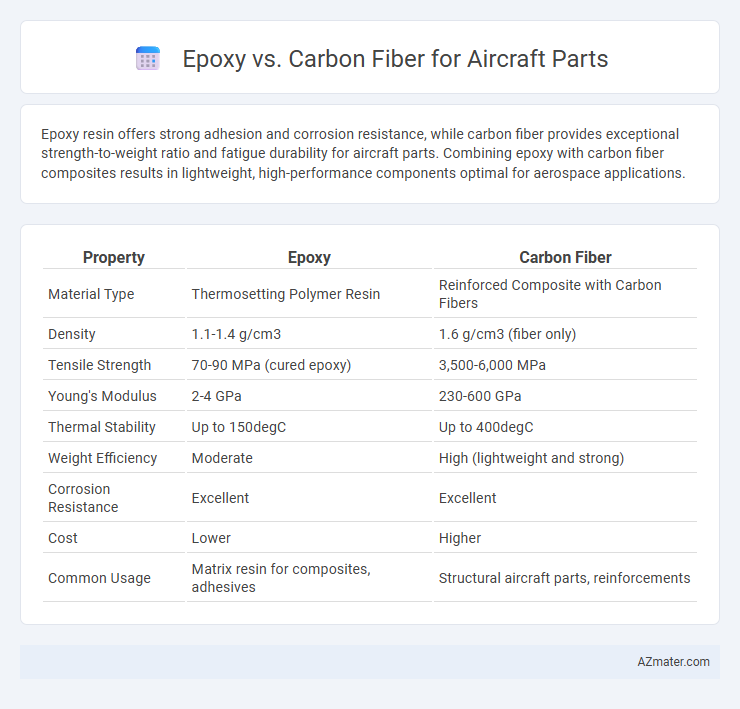Epoxy resin offers strong adhesion and corrosion resistance, while carbon fiber provides exceptional strength-to-weight ratio and fatigue durability for aircraft parts. Combining epoxy with carbon fiber composites results in lightweight, high-performance components optimal for aerospace applications.
Table of Comparison
| Property | Epoxy | Carbon Fiber |
|---|---|---|
| Material Type | Thermosetting Polymer Resin | Reinforced Composite with Carbon Fibers |
| Density | 1.1-1.4 g/cm3 | 1.6 g/cm3 (fiber only) |
| Tensile Strength | 70-90 MPa (cured epoxy) | 3,500-6,000 MPa |
| Young's Modulus | 2-4 GPa | 230-600 GPa |
| Thermal Stability | Up to 150degC | Up to 400degC |
| Weight Efficiency | Moderate | High (lightweight and strong) |
| Corrosion Resistance | Excellent | Excellent |
| Cost | Lower | Higher |
| Common Usage | Matrix resin for composites, adhesives | Structural aircraft parts, reinforcements |
Introduction to Aircraft Material Selection
Epoxy resins offer exceptional bonding strength and chemical resistance, making them ideal for composite aerospace structures requiring durability and lightweight properties. Carbon fiber composites provide superior tensile strength and stiffness while significantly reducing overall aircraft weight, enhancing fuel efficiency and performance. Selecting materials for aircraft parts involves balancing mechanical properties, weight, environmental resistance, and cost-effectiveness to meet stringent safety and regulatory standards.
Overview of Epoxy Composites
Epoxy composites are widely used in aircraft parts due to their excellent mechanical properties, including high strength-to-weight ratio and superior resistance to fatigue and environmental degradation. These thermosetting polymers provide strong adhesion to reinforcing fibers, enhancing overall composite performance and durability under aerodynamic stress. The ease of processing and curing, combined with good thermal stability, makes epoxy composites a preferred matrix material in aerospace structural components.
What is Carbon Fiber?
Carbon fiber is a high-strength, lightweight composite material composed of thin strands of carbon atoms tightly bonded in a crystalline formation, offering superior stiffness and tensile strength compared to traditional materials. It is extensively used in aircraft parts for its exceptional strength-to-weight ratio, corrosion resistance, and fatigue performance, which enhance fuel efficiency and structural durability. Unlike epoxy alone, carbon fiber must be combined with a resin matrix, such as epoxy, to form a rigid, load-bearing composite ideal for aerospace applications.
Strength and Durability Comparison
Carbon fiber composites exhibit superior tensile strength and stiffness compared to epoxy alone, making them ideal for high-stress aircraft components requiring lightweight durability. Epoxy resins serve as the matrix material that binds carbon fibers, enhancing overall composite toughness and resistance to environmental degradation. The combination of carbon fiber reinforcement with epoxy resin results in aircraft parts that offer enhanced fatigue resistance and long-term structural integrity under cyclic loading conditions.
Weight Considerations for Aircraft Parts
Epoxy composites and carbon fiber materials are critical in aircraft part manufacturing, with weight playing a decisive role in performance efficiency. Carbon fiber offers superior strength-to-weight ratio compared to epoxy alone, significantly reducing overall aircraft weight while maintaining structural integrity. Selecting carbon fiber reinforced epoxy optimizes weight savings and enhances fuel efficiency, crucial for aerospace applications.
Cost Analysis: Epoxy vs Carbon Fiber
Epoxy resin typically costs significantly less than carbon fiber, making it a more budget-friendly option for aircraft parts in terms of raw materials. While carbon fiber offers superior strength-to-weight ratio and durability, its higher production and processing expenses increase the overall cost of manufacturing aircraft components. The cost analysis must weigh initial material expenses against long-term performance benefits and maintenance requirements when choosing epoxy or carbon fiber for aerospace applications.
Manufacturing and Application Differences
Epoxy resin serves as the primary matrix material in composite aircraft parts, offering excellent adhesive properties and chemical resistance, while carbon fiber provides exceptional tensile strength and stiffness as the reinforcement. Manufacturing with epoxy involves curing at controlled temperatures to achieve desired mechanical properties, whereas carbon fiber components require precise layering and alignment of fibers to maximize load-bearing capabilities. In application, epoxy composites are valued for their durability and ease of repair, while carbon fiber parts deliver superior weight savings and structural performance, critical for high-stress aircraft components.
Environmental Resistance and Lifespan
Carbon fiber composites exhibit superior environmental resistance compared to standard epoxy due to their high strength-to-weight ratio and enhanced durability against moisture, UV radiation, and temperature fluctuations, making them ideal for aircraft parts exposed to harsh external conditions. Epoxy resins, while providing excellent adhesion and chemical resistance, tend to degrade faster under prolonged exposure to environmental stressors, which can reduce the aircraft component's lifespan. Combining carbon fiber with advanced epoxy formulations can significantly extend the service life of aircraft parts by optimizing resistance to corrosion, fatigue, and environmental wear.
Common Aircraft Parts Using Each Material
Epoxy composites are commonly used in aircraft parts such as interior panels, fairings, and secondary structural components due to their excellent adhesion and resistance to environmental factors. Carbon fiber is preferred for primary structural elements like wing spars, fuselage frames, and control surfaces because of its superior strength-to-weight ratio and stiffness. Selecting between epoxy and carbon fiber depends on the specific performance requirements and mechanical properties needed for different aircraft components.
Choosing the Right Material: Key Factors
When selecting the right material for aircraft parts, key factors include weight, strength, durability, and cost-effectiveness. Epoxy composites offer superior chemical resistance and excellent bonding properties, making them ideal for structural adhesives and coatings, while carbon fiber provides unmatched strength-to-weight ratio, crucial for load-bearing components in aerospace applications. Assessing environmental conditions, fatigue resistance, and manufacturing processes ensures optimal performance and safety standards in aviation materials.

Infographic: Epoxy vs Carbon fiber for Aircraft part
 azmater.com
azmater.com